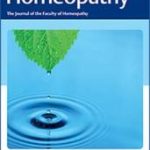Diana Keller, Isabel Blanco-Penedo, Manon De Joybert & Albert Sundrum
How target-orientated is the use of homeopathy in dairy farming?—A survey in France, Germany and Spain
Acta Vet Scand, 2019, 61 (30), 1-12

Background – Veterinary remedies are intended to support animals in their recovery from diseases. Treatment outcome depends not only on the general effectiveness of the remedies themselves, but also on other prerequisites. This is true for antibiotics, but even more so for treatments with homeopathic products which are characterised by their individualised approach. While the effectiveness of homeopathy has been addressed in various clinical control trials, the practical conditions under which homeopathic products are used on dairy farms have not yet been investigated. This study provides an initial insight into the existing prerequisites on dairy farms for the use of homeopathy (i.e. the consideration of homeopathic principles) and on homeopathic treatment procedures (including anamnesis, clinical examination, diagnosis, selection of a remedy, follow-up checks, and documentation) on 64 dairy farms in France, Germany and Spain. The use of homeopathy was assessed via a standardised questionnaire during face-to-face interviews. Results – The study revealed that homeopathic treatment procedures were applied very heterogeneously and differed considerably between farms and countries. Farmers also use human products without veterinary prescription as well as other prohibited substances. Conclusions – The subjective treatment approach using the farmers’ own criteria, together with their neglecting to check the outcome of the treatment and the lack of appropriate documentation is presumed to substantially reduce the potential for a successful recovery of the animals from diseases. There is, thus, a need to verify the effectiveness of homeopathic treatments in farm practices based on a lege artis treatment procedure and homeopathic principles which can be achieved by the regular monitoring of treatment outcomes and the prevailing rate of the disease at herd level. Furthermore, there is a potential risk to food safety due to the use of non-veterinary drugs without veterinary prescription and the use of other prohibited substances.






Lascia un commento
Devi essere connesso per inviare un commento.